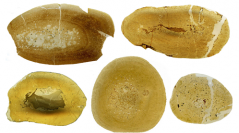

 Comptes Rendus Palevol
15 (1-2) - Pages 142-162
Comptes Rendus Palevol
15 (1-2) - Pages 142-162Simosaurus gaillardoti was a large eosauropterygian (Sauropterygia), a group of diverse diapsid marine reptiles. Its occurrence correlates to transgression phases in the Germanic Basin and a former morphological study hypothesized that Simosaurus was capable of sustained swimming. Microanatomical analysis of five long bones revealed functional differences between the humerus and femur but did not confirm sustained swimming in Simosaurus. It had certain active swimming abilities but – based on microanatomy – it was a less efficient swimmer when compared to contemporaneously living nothosaurs. Simosaurus grew with well-vascularized coarse parallel-fibred bone tissue. Growth marks appear as broad zones and thin annuli. Two specimens show an external fundamental system in their outer cortex. For three samples the logistic growth model best describes growth in Simosaurus. The estimated ages at death range between 7 and 13 years, asymptotic masses range between 113 and 129 kg and were reached after 10 up to 20 years. Maximum growth rates were between 44 and 69 g per day, and higher than of an extant similar-sized reptile such as Varanus komodoensis, Alligator mississippiensis, and Caretta caretta, but are still consistent with the variability seen in extant reptiles. Growth of one femur followed the von Bertalanffy model but the model's biological reliability is questionable due to an unrealistic high hatchling mass.
Coarse parallel-fibred bone, Growth models, Growth rates, Life history data